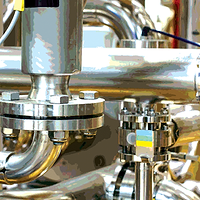Preventive Maintenance: An Essential Prerequisite for Food Safety

Food safety professionals expect all processors, large and small, to have prerequisite programs in six areas:
• Sanitation Standard Operating Procedures
• Good Manufacturing Practices
• Preventive Maintenance
• Product Identification
• Traceability and Recalls
• Education and Training
Preventive maintenance is not only a prerequisite program, it is also one area where a well-documented program can provide a company not just with significant cost savings but also with data for future savings. In the context of food safety management, well-maintained equipment will ensure that a facility runs smoothly, works properly, helps ensure the production of safe foods and provides a means to document performance.
A number of foodborne outbreaks have been directly attributed to failure to properly maintain equipment under sanitary conditions. One of the most famous was the type E botulism outbreak of the early 1980s that was caused by improperly performing can reformers. The problems with the reformers led to more intense monitoring of these units and their eventual phase-out in favor of nested cans. Improper equipment maintenance was once a major cause of foreign materials complaints. However, with increased use of metal detection systems and an enhanced commitment to maintenance programs, foreign material complaints are now far fewer.
But preventive maintenance is much more. It protects equipment, extends said equipment’s life and enhances operating efficiencies. There are many other preventive maintenance activities that we take for granted. Most people see their dentist once or twice a year to have their teeth cleaned to ensure that they last and to minimize cavities. Additionally, who doesn’t bring their car in for a checkup before a family vacation? The last thing anyone wants to do on a summer vacation is break down in the middle of nowhere. The bottom line is that preventive maintenance provides peace of mind for people and food processors, and is one program where benefits, both quality and economic, can be measured (for an outline to help you draft or evaluate your preventive maintenance procedures, please see the sidebar).
Starting Out
Perhaps the best way to begin developing a preventive maintenance program is to take inventory. There are different ways to do this. A small facility might make a master list of all equipment requiring maintenance, whereas a large facility can set up their master list by processing line or process area. The master list (Figure 1) should include the following:
 • Equipment name
• Equipment name
• Location
• Serial number
• Description
• Maintenance schedule
• Responsibility
• Procedures
For most pieces of equipment, there are several different maintenance schedules. There is routine maintenance, that is, what is done daily, lubrication schedules and different kinds of more complex maintenance. As an example, it is normal in most operations to shut down a piece of equipment at least once a year for a complete check. However, the schedule may also call for replacing gaskets or some other item every month. Therefore, the bottom line is that for each piece of equipment, there are several levels of maintenance.
When establishing maintenance schedules, a risk assessment on each piece of equipment should be conducted. How important is that operation or activity to product quality, safety or legal compliance? Let’s look at something as simple as a gasket. Too many processors let gasket changing or inspection slide. But if a gasket breaks down and the company ends up with a foreign materials complaint or spoilage, they suddenly get religion. Gasket inspection or replacement is deemed a high-risk activity and must be scrupulously adhered to. When this exercise is done, the company will have established high-, medium- and low-risk activities. Based on the risk assessment, the operation may decide to perform maintenance activities more or less frequently.
Maintenance Procedures
It has been said that “If it is not written down, it never happened.” Therefore, it is absolutely imperative that the maintenance program include procedures that describe how to do the work and properly document that the work is being done and being done properly. The maintenance master list would be only one document in the program. The following procedures would be considered integral parts of a documented maintenance program:
• Maintenance procedures
• Lubrication procedures
• Tool reconciliation procedures
• Procedures for temporary repairs
• Procedures for emergency repairs
• Spare parts inventory program
• Training procedures
• “Hand-over” procedures
• Audit procedures to verify that the work is being done properly
Let’s look at how these protocols should be drafted. Food processors should establish a standard for drafting, reviewing and approving procedures. These should include a title, step-by-step actions to complete the work, who is responsible for the work, how and where records shall be maintained (references to the appropriate form or forms), corrective actions to be carried out and, finally, procedures for management to verify that the work was not only done, but done properly. When developing preventive maintenance procedures, the company should draw on the manuals provided by the equipment manu-facturers, the risk assessments they have conducted and their own experiences. In most cases, equipment manuals are far too detailed and bulky for everyday use, so procedures need to be streamlined.
Lubrication is always a hot button issue during third-party audits. The lubrication procedures should describe not only how and when to lubricate, but should specify the type and amount of lubricant. Ideally, the lubrication records should capture all of this information. The lubrication program should also include procedures describing how food- and nonfood-grade lubricants are identified to ensure that the proper material is used. Processors are now color-coding lubricants and/or the grease guns used to apply them. Since this is an important issue, suppliers of lubricants have stepped forward to help ensure better control of lubricants. Some vendors now sell color-coded lubricants (Figure 2).

The best way to describe tool and parts reconciliation is to look at the medical profession. One of the things done during surgeries is to ensure that all tools present at the start of the operation are there when the work is done. One doesn’t want to leave something in the patient, which does happen. There are different ways to ensure tools are reconciled.
One is to set up a tool cabinet in the area of the machinery being maintained, with a location for each tool (Figure 3). If a tool is missing from the cabinet after a project, it must be accounted for. When using a system such as this, companies assign keys to selected individuals, which both controls access and defines who is responsible for tool reconciliation. Another means to reconcile tools is to have the maintenance people supply their own tools. They are more prone to keep an eye on their own property. Many companies do this. An integral part of such programs is to provide the maintenance people with a tool allowance to ensure they have what they need. Finally, an outfit can use a checklist like surgeons do. What goes into the plant must be accounted for when the work is completed.

All companies must establish a procedure for temporary repairs, which use many different materials. These include tape of various types, string, wire, twist-ties and cardboard. None of these items is considered proper material for doing repairs. In fact, there is a good chance that they could cause product contamination. If one or more of these items are used, the repair should truly be temporary, that is, less that a 24-hour fix, and preferably only one shift. The fix should be dated and be properly repaired as soon as possible. Of course, the best course is not to use any of these items and simply fix the problem immediately.
The maintenance program should also include spare parts. All processors need to maintain a spare parts inventory to keep the plant running smoothly. However, it is impossible to keep a backup for every single unit in a plant. There are cost, space and management issues. This is another situation where risk assessment can be used effectively. Processors need to understand the potential risks of being down because of a part or equipment failure. For example, is it worth maintaining a unit with a temporary fix if the instrument or part can be delivered within a few hours?
Processors should also establish a hand-over procedure. Whenever repairs are made, quality should look over the unit in question to ensure that it is clean, the work has been done properly and the unit is ready to go. Quality must then sign off on the repairs prior to restarting production operations.
To ensure everything is done properly, everyone involved in the program needs to be trained on procedures. Training should be based on established protocols and fully documented.
Finally, the company needs to establish internal audit protocols to verify that each of the procedures is being done properly and is documented.
Maintenance Records
Preventive maintenance records can be maintained as hard copies or electronic records. Small-to-medium operators generally maintain hard-copy records. Possibly the greatest challenge with these kinds of records is tracking when things are to be done. There is simply a greater probability that something will slip through the cracks. What more and more companies are doing is adopting electronic maintenance management systems. These can be developed in-house using programs such as Excel or Access, or processors can choose a commercially available product, of which there are many options. Features an operator might look for in an electronic system include:
• Maintenance scheduling
• Flags when items are due
• Flags for past-due items
• Cost integration: maintenance hours, capital costs, parts, downtime, etc.
• Procedures for doing work
• Automatic entry by workers
• Ability to verify that work has been done
• Print capability: summaries, schedules, equipment registers
• Ability to “talk” to other systems
The biggest issue with such systems is setup. It takes a great deal of time and effort to enter all the necessary information into the system. In fact, from what I have seen in the industry, most processors who are utilizing an electronic maintenance management system are not using it to its full capability. Perhaps the best use of a system I have ever seen was a processor who elected to incorporate their maintenance management into their system. The program manager could capture all hours involved with maintenance and emergency repairs, plus the cost of spare parts and downtime for each unit operation in every line in the plant. He could demonstrate how much it cost to run each unit operation and/or piece of equipment in a line, and therefore the cost to operate each line. This allowed the company to determine which pieces of equipment were operating efficiently and which were not. They used these data year to year to further improve efficiencies.
Another advantage of an electronic system is that it can be expanded to incorporate other programs. As an example, I have seen many operations that have rolled their calibration programs into the preventive maintenance program. They may also be used to schedule both sanitation period cleaning and maintenance. This helps coordinate two functions essential for ensuring safety, quality and efficient operation of equipment. Combining such activities during shutdowns or downtime makes better use of time and resources and maximizes production efficiency.
There are a large number of electronic maintenance management systems on the market. Rather than try to list all and perhaps offend someone who was left out, I encourage you to search the Internet and talk to colleagues in the industry about their experiences with them.
If a company does elect to use an electronic system, they must be sure to train several people on the system. It seems like a no-brainer, but I have seen more than one operation that abandoned an electronic system because no one else knew how to use it when the systems manager left the company.
Summary
A well-organized preventive maintenance program is an essential part of a company’s food safety and quality program. It is acknowledged as one of the prerequisite programs for Hazard Analysis and Critical Control Points. What it can also do is save money in different ways. Well-maintained, sanitary equipment will last longer and perform better. In addition, maintenance records can provide management with a tool for more intelligent purchasing of new equipment. Cost is only one consideration when buying equipment. If the records indicate that a piece of equipment was down often or very expensive to maintain, maybe it is not a brand that one should buy again. And finally, without records, how does one ever troubleshoot a problem? A food processor simply cannot operate without a good maintenance program.
Richard F. Stier is a consulting food scientist with international experience in food safety, plant sanitation, quality systems, process optimization and microbiology. Among his many affiliations, he is a member of the Institute of Food Technologists and an editorial adviser to Food Safety Magazine. He can be reached at rickstier4@aol.com.
Sidebar
Outline for Effective Preventive Maintenance
SUBJECT: PREVENTIVE MAINTENANCE: General Procedure
OBJECTIVE: To develop, document, implement and maintain a preventive maintenance program that ensures safe and sanitary operation of all equipment essential for maintaining quality and safety of products. This program may also be used to monitor operational efficiencies and to evaluate machine performance that may be used for future equipment purchases.
PROCEDURE: This plant shall develop, document, implement and maintain a preventive maintenance program for all equipment used to ensure quality and safety of foods or ingredients or which may affect product safety, quality or integrity. The preventive maintenance program shall include the following elements at a minimum:
• Master list of all equipment requiring maintenance
• Maintenance schedules for all equipment
• Documented procedures for maintaining equipment
• Record-keeping procedures for all maintenance, including emergency maintenance and repairs, on all equipment
• Reconciliation program for tools
• Lubrication programs for all equipment, including type of lubricant, lubricant schedule, amount of lubricant applied and records that the lubrication program has been followed
• Procedures for handing over equipment to production following preventive or emergency maintenance
• Spare parts inventory and maintenance
RESPONSIBILITY: Owner
Looking for a reprint of this article?
From high-res PDFs to custom plaques, order your copy today!








